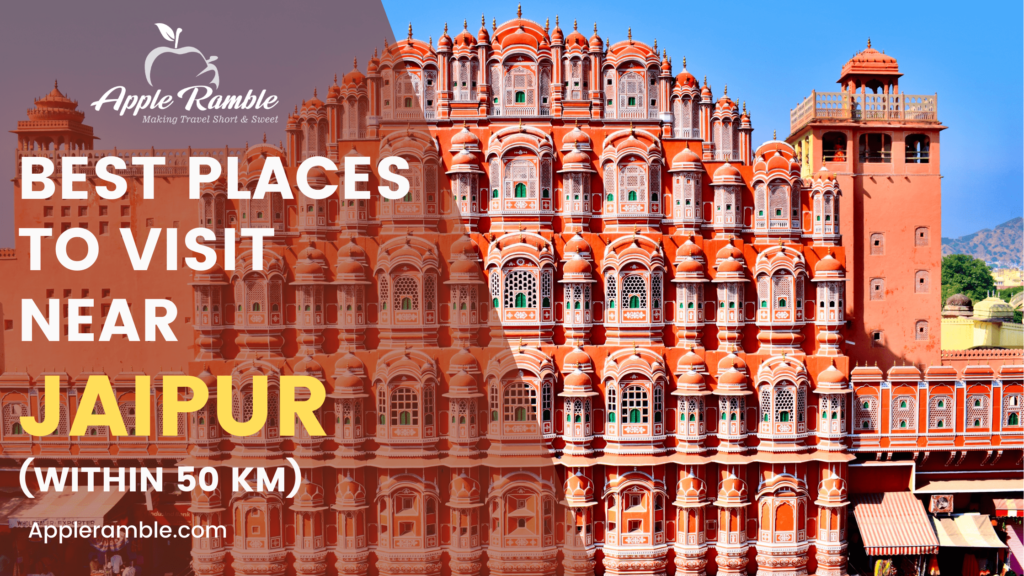Jaipur – widely popular as the “Pink City” for its trademark traditional building color is the capital city of Rajasthan. top 10 tourist places in Jaipur was founded by King Jai Singh II (a Kachhwaha Rajput) in 1727. The city was thus named after him. Designed by Vidyadhar Bhattacharya, the city of Jaipur is one of the earliest planned cities in India and is also known as the “Paris” of India.
Jaipur is one of the most popular tourist destinations in India and forms a part of the Indian Golden Triangle along with Delhi and Agra. Jaipur houses a few of the UNESCO World Heritage sites such as Amber Fort, and Jantar Mantar and in 2019 was inscribed as the “Pink City of India” by UNESCO. Apart from its architectural wonders such as the Birla Auditorium, Albert Hall Museum, Hawa Mahal, Jal Mahal, and Amber Fort – Jaipur also is a perfect retreat for art and cultural heritage lovers.
The city of top 10 tourist places in jaipur is easily accessible by all three means- road, air, and rail. The city is also well-connected internally making it easier to travel from one monument to another. To explore the historical streets of Jaipur, you can either hire an affordable and trusted Apple Ramble Jaipur Taxi Service for Jaipur airport and railway transfer or you could go for the traditional and local Jaipur TukTuk Tour (Auto Rickshaws) (or as we like to call them- the Indian Helicopter).
The colorful history of the Pink City is showcased in almost all corners of the city in terms of art, architecture, lifestyle, and culture. The Jawaharlal Kala Kendra preserves Rajasthani arts and crafts. Along with the Government Central Museum which hosts multiple art and antiquities. Apart from these, you can also explore the streets of Jaipur to experience the cultural paradigm of the city. You will find shops for traditional handicrafts and antiques. These crafts usually showcase art forms like Bandhani, Block Printing, Stone Carving, Zari, Gota-Patti, Kundan, Blue Pottery, and more.
And if that does not amuse you, the traditional Jaipur food most definitely would! The typical food consists of Dal Baati Churma, gate ki Sabzi, Ker Sangri, Missi Roti, Laal Maans, etc. the most popular sweets that you must try during your visit are – Ghevas, Feeni, Gajak, Meethi Thuli, Mawa Kachori, etc.
top 10 tourist places in jaipur for a Memorable Trip
1) Amber Palace
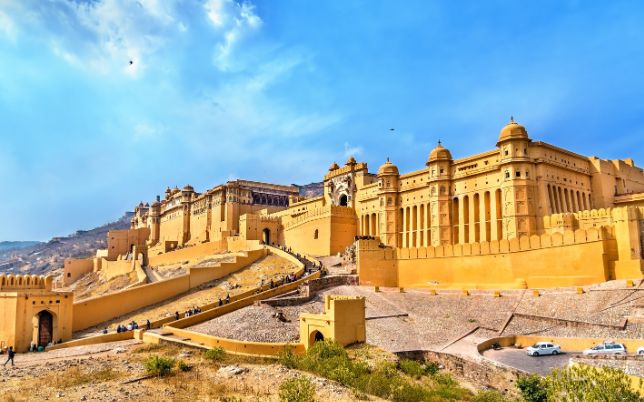
Located 11 km from Jaipur, Amber Palace is one of the UNESCO World Heritage sites. It is situated in Craggy Hills and forms a mesmerizing amalgamation of Hindu and Mughal styles. The construction of the Amber Palace started in the year 1592 and it was built as a haven against enemy attacks.
The palace is a harsh-looking exterior but as you move inside, it is equally warm and welcoming. It kind of contrasts the external facades. Amber palace is made of Red Sandstone and white marble accompanied by stone carvings, mirrors, and precious stones. The palace is also flourished by the breathtaking Maota Lake at its front. The originally acquired small structure from Meena tribes currently stands tall and proud for nearly 7 centuries now.
Timings:
- Fort timings: 9:00 am to 6:00 pm every day.
- Night Light & Sound Show Timings: 7:30 pm and 8:00 pm
- Entry fees: Rs 25 for locals, Rs 200 for foreigners, Rs 10 for students
2) City Palace

The city palace was built by Maharaja Sawai Jai Singh II and is located deep within the walled city. Currently, the palace is still a home to the last ruling royal family who stay in a private section of the palace. The premises of the city palace consist of Mubarak Mahal and Maharani Palace which are the palace of reception and the palace of the queen respectively. The palace is a beautiful fusion of Rajput and Mughal architecture and displays the royal history throughout.
The Mubarak Mahal houses a museum that houses a unique and huge collection of royal costumes, delicate Pashmina (Kashmiri) shawls, Banaras silk saris, etc. it is dedicated to the Maharaja Sawai Man Singh I and II. The Maharani palace on the other hand displays Rajput weaponry dating back to the 15th century. Apart from this the city palace also displays beautiful paintings on the ceiling.
Timings:
- Entry fees: Rs 40 for locals, Rs 300 for foreigners
- Visit More: Jaipur Sightseeing Tour and Packages
3) Jantar Mantar
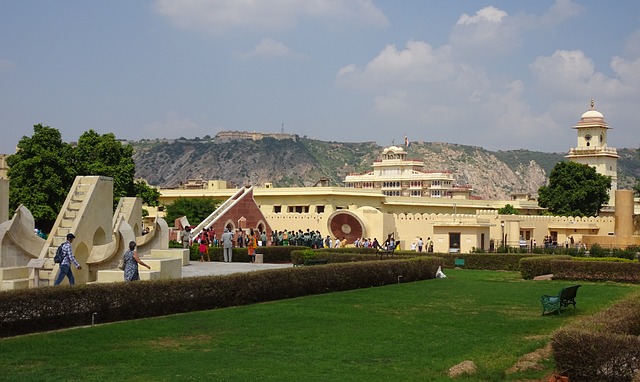
Jantar Mantar is one of the largest astronomical observatories in India. It was built by Maharaja Sawai Jai Singh II and is now a UNESCO World Heritage site. Jantar Mantar is one of the oldest astronomical observatories but is no longer functioning as a science center. It is maintained as a monument and comprises marvelous stone assemblies which help in interpreting the position of celestial bodies and calculating local time.
Jantar Mantar was built in 1734 and has been protected as the National Monument of Rajasthan since 1968. The monument consists of 19 instruments to measure the distance and position of the celestial bodies. These instruments are carved out of stone and depict different geometric shapes. A few of the structures within Jantar Mantar are Vrihat Smarat Yantra, Laghu Smarat Yantra, Ram Yantra, Jaya Prakash Yantra, Chakra Yantra, Digamsa, Nadivalaya, Karnti Vritya.
Timings: 9:30 am to 4:30 pm every day
Entry fees: Rs 50 for locals, Rs 200 for foreigners
4) Hawa Mahal

Hawa Mahal, as the name suggests is the palace of wind. It was built by King Sawai Pratap Singh in 1799 as a summer retreat for him and his family. It was also used as an observatory by the women of the house to observe everyday life from inside the palace without being seen. The exterior of the Hawa Mahal is a blend of Hindu and Islamic architecture and has Jharokhas (small latticed windows) that resemble the crown of Lord Krishna. The windows act as a screen allowing the cool air inside the palace making it a perfect retreat from summer.
The Hawa Mahal is a five-storied structure and is made entirely out of pink sandstone. It is an iconic landmark of Jaipur tourism and its grandeur is visible from any part of the street. Currently, the Mahal is maintained by the Archaeological Department of the Government of Rajasthan and also houses a museum in its courtyard.
Timings: 9:00 am to 4:30 pm every day
Entry fees: Rs 10 for locals, Rs 50 for foreigners
5) Albert Hall Museum (Central Museum)
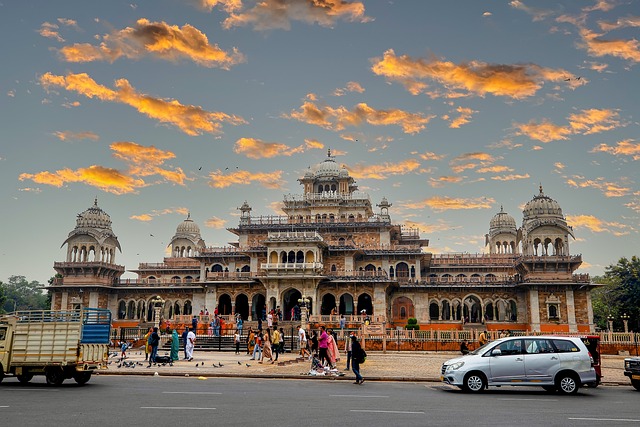
The Albert hall museum, also known as the central museum is located in the center of Ram Niwas Garden. It gets its inspiration from the Victoria and Albert Museum in London. The Albert hall museum follows the Indo-Sarcenic style of architecture and the design was conceptualized by Sir Swinton Jacob – who is also the mastermind behind many other monuments in Rajasthan. The foundation stone of the central museum was laid in the year 1876 by the Prince of Wales.
Inside the museum is a display of a wide range of metal sculptures, wood crafts, carpets, stone and metal objects, arms and weapons, natural stones, and ivory goods, etc. along with this the museum also consists of a huge collection of miniatures from Bundi, Kota, Kishangarh, Udaipur, and Jaipur schools of art.
Timings: 9:00 am to 5:00 pm, 7:00 pm to 10:00 pm every day
Entry fees: Rs 20 for locals, Rs 150 for foreigners
6) Nahargarh Fort
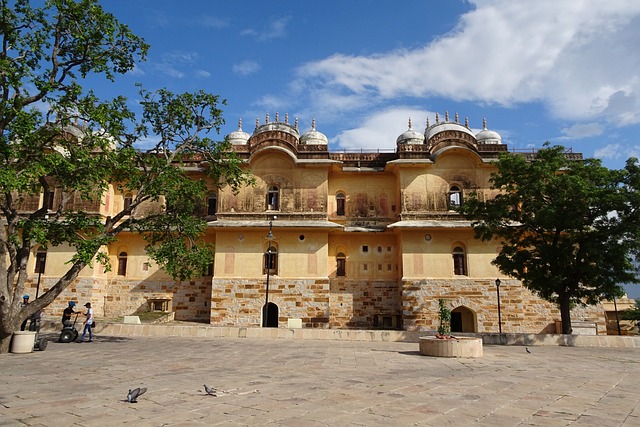
Standing tall as the northern backdrop to the city of Jaipur, the Nahargarh Fort is one of the most visited and famous tourist places in Jaipur. Sitting proudly on the top of the Aravalli Hills, the fort was built in 1734 during the reign of Jai Singh. Nahargarh fort served as a barrier for Top 10 tourist places in Jaipur protecting it from enemy attacks.
The Nahargarh fort was built by Sawai Madho Singh and concludes 12 matching boudoirs for the queens along with a suite for the king at the head. All the suites are connected by corridors and are decorated with delicate murals. The fort also houses Madhavendra Bhawan which acts as the summer destination for the royal family. Today, the fort acts as a picnic spot for its visitors. At night, the fort glistens with floodlights overlooking the mesmerizing view of the city.
Timings: 9:30 am to 5:30 pm every day
Entry fees: Rs 10 for locals, Rs 50 for foreigners
7) Birla Temple

Birla temple is also known as the Lakshmi-Narayan temple. Located at the base of Moti Dungari, the Birla temple was commissioned and developed in 1988 by the renowned Indian industrialist – the Birlas. The temple is dedicated to lord Vishnu and his companion Lakshmi, who is the goddess of good fortune and wealth.
The Birla temple is built on an elevated platform and is built entirely out of white marble standing out against the skyline of south Jaipur. The temple is covered overall with carvings and sculptures depicting multiple mythological themes. The images of the Gods (Lord Vishnu and goddess Lakshmi) are carved out of single stone making the highlight of the temple. To pay homage to the secular and diverse India, the top of the temple is crowned with three domes depicting the three different religions followed in India.
Apart from the main temple, the temple complex also houses a museum exhibiting the earlier belongings of the Birla family.
Timings: 8:00 am to 12:00 pm and 4:00 pm to 8:00 pm
8) Jaigarh Fort
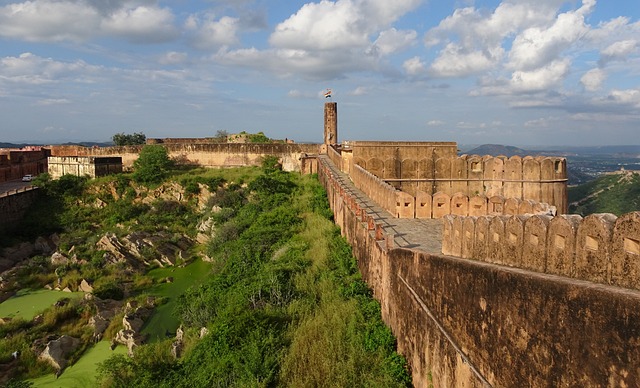
Jaigarh Fort is another most visited tourist destination in Jaipur. It is located at 15kms from Top 10 tourist places in city and was built by King Sawai Jai Singh II. The fort is believed to be built somewhere around the 18th century. Jaigarh Fort is located between the rocky, arid, thorn scrub of the Ravalli hills.
Jaigarh Fort was initially built to protect the Amber Fort and is also architecturally similar to the Amber Fort. It is also known as the Victory Fort. The fort features a cannon called “Jaivana” which was the largest cannon in the world during that time and was built within the fort premises itself. Jaigarh Fort and amber fort are considered one complex and are connected by subterranean passages.
Timings: 9:00 am to 4:30 pm every day
Entry fees: Rs 35 for Indians, Rs 80 for foreigners
9) Jal Mahal
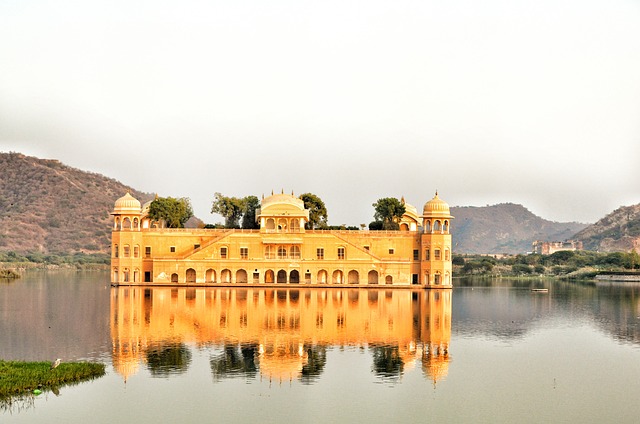
The word Jal translates to “water” and thus the name Jal Mahal means “water Palace”. Although it is built in a royal palace style, Jal Mahal was initially built by Maharaja Madho Singh I as a hunting lodge instead of a palace. The king would use the Mahal as an entourage during his duck-hunting trips. Today, the palace is a great landmark for sightseeing amongst tourists for its beautiful scenery. The Jal Mahal stands proud in the middle of the Man Sagar Lake and is visited by thousands of tourists each year.
Covered in beautiful, mesmerizing pink sandstone the Jal Mahal is more than what meets the eye. The technology and innovative design of the palace are considered the most remarkable system of that time. From the surface, it might look like the palace is only one level, but there are a total of four submerged levels in it. The stone walls hold back tonnes of water each day and the water seepage is controlled by the specially designed lime mortar.
The palace is not open to view for the public from the inside but tourists can visit the lake and view the grandeur of the Jal Mahal from the banks of the lake.
10) Sisodia Rani Palace and Garden
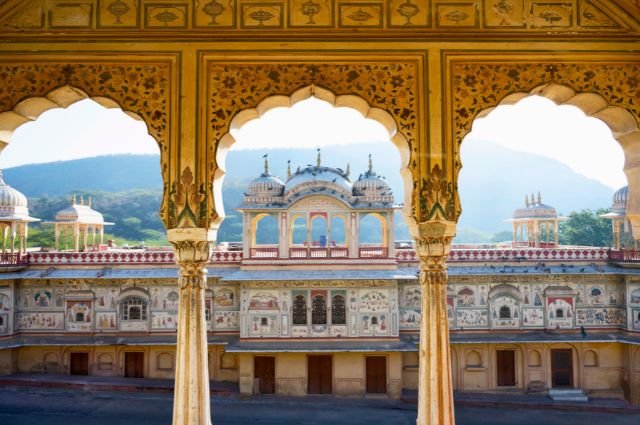
Built in 1728 by Maharaja Sawai Jai Singh II, Sisodia Rani Palace, and Garden is located at 6kms from Jaipur. There are tiered multi-level gardens with fountains inside the complex, along with watercourses and painted pavilions. The top terrace of the garden is occupied by a double-storied palace. The palace includes many galleries, pavilions, and hallways. Each gallery, hallway, and pavilion depicts the life of lord Krishna in terms of murals and paintings.
The garden palace is dedicated to Queen Sisodia and it has derived its name from the same. The mesmerizing architecture of the Sisodia palace and garden is something one should not miss during their visit to Jaipur.
Timings: 8:00 am to 5:00 pm every day
Entry fees: Rs 50 for locals, Rs 200 for foreigners
Apart from these astonishing places, there are many other forts, sightseeing palaces, and lakes that you can visit in Top 10 tourist places in Jaipur. Each palace and fort dictates a story of its own and carries a legacy of hundreds of years. You can wander the streets exploring the vast culture and the tradition of the city or you could simply visit any of its lakes to enjoy the serenity of the cool breeze. Either way, Jaipur has a lot to offer to each type of its visitor and makes sure you are left with nothing but content.


